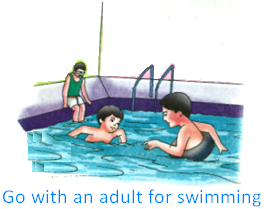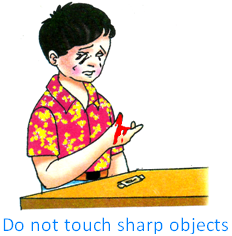Keeping Safe
Keeping safe can save us from injury. Accidents can happen anytime and anywhere. If we are not careful, we can hurt ourselves. Keep safety rules in our mind to keep ourselves safe.
Questions and answers on safety rules and first aid we need to obey on the road, inside a vehicle, in the swimming pool, in the playground, at home and when we get hurt.
1. What are the important safety rules we need to follow on the road?
The important safety rules we need to follow on the road are:
(i) walk on the footpath.
(ii) cross the road only at the zebra crossing.
(iii) cross the road when the traffic light is green for us.
(iv) do not cross the road when the traffic light is red for us.
(v) look at both sides before crossing the road.
(vi) do not run on the road.
2. What are the
important safety rules we need to follow in the bus or vehicles?
The important safety rules we need to follow in the bus or vehicles are:
(i) do not get in or get off a moving bus.
(ii) do not stick your head or hand out of the bus you are in.
(iii) do not shout and scream in the bus.
(iv) standing in a queue to board a bus is a good habit.
(v) do not disturb the driver while he drives the bus.
(vi) never open the door of a moving vehicle.
3. What are the important safety rules we need to follow in the swimming pool?
The important safety rules we need to follow in the swimming pool are:
(i) go with an adult to the pool. Do not go alone.
(ii) do not go to the deep side of the pool.
(iii) if we do not know how to swim, use swimming tubes, floaters or arm-bands for swimming.
(iv) do not eat while swimming
(v) do not run around the pool.
(vi) do not push or pull each other into to the pool.
4. What are the important safety rules we need to follow in the playground?
The important safety rules we need to follow in the playground are:
(i) follow rules while playing the game.
(ii) we need to wait for our turn on swings. Do not stand in front of swings.
(iii) play in a safe place like a park or a playground. Do not play on the road.
5. What are the important safety rules we need to follow at home?
The important safety rules we need to follow at home are:
(i) we need to keep our toys and books and other things at proper places.
(ii) do not touch electric wires, matchsticks or sharp objects like knives, pins and blades. These can hurt us.
(iii) stay away from plug points and sockets.
(iv) do not play with fire.
(v) never tease pets or animals.
(vi) never taste medicines. They can be poisonous.
6. What are the important safety rules we need to follow if we get hurt?
The important safety rules we need to follow if we get hurt are:
(i) for keeping safe we need to keep calm. Don’t feel scared or shout.
(ii) we need to quickly inform an elder around us, they will help us.
(iii) visit a doctor if required.
Note:
For keeping safe we need to follow the measures taken to stay away from harm.
From Keeping Safe to HOME PAGE
Recent Articles
-
Explain about Growth in Plants |Definition of Growth & Differentiation
Feb 27, 25 02:07 PM
Growth is a permanent increase in length or volume of an organism that brought upon by an increase in its dimensions due to synthesis of new protoplasmic material. -
Definition of Respiratory Quotient | calculation | Application | Plant
Dec 02, 24 12:09 AM
Definition of respiration quotient- the ratio of the carbon-dioxide evolved to that of the oxygen consumed by a cell, tissue, plants or animals in a given time is called respiratory quotient. It is us… -
Amphibolic Pathway | Definition | Examples | Pentose Phosphate Pathway
Jun 06, 24 10:40 AM
Definition of amphibolic pathway- Amphibolic pathway is a biochemical pathway where anabolism and catabolism are both combined together. Examples of amphibolic pathway- there are different biochemical… -
Respiratory Balance Sheet | TCA Cycle | ATP Consumption Process
Feb 18, 24 01:56 PM
The major component that produced during the photosynthesis is Glucose which is further metabolised by the different metabolic pathways like glycolysis, Krebs cycle, TCA cycle and produces energy whic… -
Electron Transport System and Oxidative Phosphorylation | ETC |Diagram
Feb 04, 24 01:57 PM
It is also called ETC. Electron transfer means the process where one electron relocates from one atom to the other atom. Definition of electron transport chain - The biological process where a chains…









New! Comments
Have your say about what you just read! Leave me a comment in the box below.